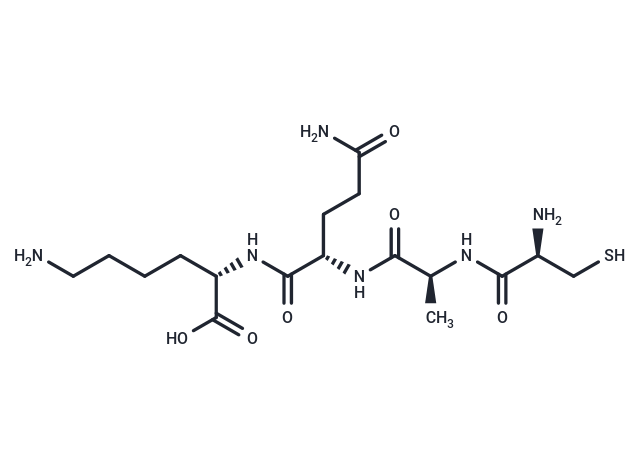Shopping Cart
- Remove All
 Your shopping cart is currently empty
Your shopping cart is currently empty

CAQK peptide specifically binds to injured mouse brain tissue and targets demyelinating areas without affecting healthy tissue. It interacts with a proteoglycan complex that is upregulated in brain injuries, making it useful for drug delivery applications. Additionally, CAQK peptide can penetrate the blood-brain barrier [1] [2].

| Pack Size | Price | Availability | Quantity |
|---|---|---|---|
| 10 mg | Inquiry | Inquiry | |
| 50 mg | Inquiry | Inquiry |
| Description | CAQK peptide specifically binds to injured mouse brain tissue and targets demyelinating areas without affecting healthy tissue. It interacts with a proteoglycan complex that is upregulated in brain injuries, making it useful for drug delivery applications. Additionally, CAQK peptide can penetrate the blood-brain barrier [1] [2]. |
| In vitro | FAM-CAQK selectively associates with brain injuries caused by localized or impact trauma, without interacting with healthy brain tissue or other organs. At the lesion sites, the peptide primarily binds to the fibrous extracellular matrix (ECM) deposited in the interstitial spaces near reactive astrocytes [1] [2]. |
| In vivo | CAQK was employed in a murine model to address localized demyelination caused by acute hemolytic phospholipids. The specific dose administered was 100 nmoles in 100 μL, delivered via tail vein injection at either 24 hours or five days post-injury, targeting the injury sites located in the right abdominal area. The subjects of the study were 8-week-old male C57BL/6J mice [1]. Research findings indicate that CAQK promotes an increased density of multinuclear DAPI+ cells and fragmented myelin at the injury site, along with an accumulation of peptide substances stained for with myelin basic protein staining. Contrarily, the control group, treated with PBS sham surgery, showed no presence of these peptide substances in the spinal cord and maintained normal DAPI+ cell density. |
| Molecular Weight | 448.54 |
| Formula | C17H32N6O6S |
| Cas No. | 2088281-24-5 |
| Storage | Powder: -20°C for 3 years | In solvent: -80°C for 1 year | Shipping with blue ice. |

Copyright © 2015-2025 TargetMol Chemicals Inc. All Rights Reserved.